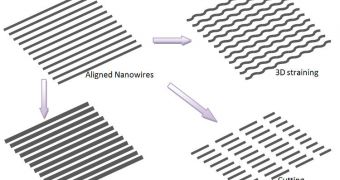A group of investigators from the Purdue University in West Lafayette, Indiana, announces the creation of a new technique for obtaining custom structures at the nanoscale. Their new approach relies on an innovative use of ultra-fast lasers.
Compared to a “nano machine shop,” the approach involves shaping various types of nanowires and ultrathin films into various types of electronics. The latter could be used to create better solar cells and to improve fields of research such as plasmonic resonance and ultrahigh magnetism.
In the future, Purdue experts want to use the laser technique to enable the development of a new generation of energy-efficient, ultrafast computers, improved optical devices and novel electronics.
Scientists even managed to use their lasers to shape graphene into molds. This material is a 2D, single-atom-thick carbon compound, which has tremendously exciting physical and chemical properties. Some believe it will replace silicon in all electronic devices some day soon.
In addition, the nano machine shop was able to produce microscale and nanoscale gears through a stamping-like procedure, synthesized rings of graphene from a larger film, and so on. The lasers were also successful in modeling the shape of silver nanowires.
The research group that developed the impressive tuning system was led by Purdue University associate professor of industrial engineering, Gary Cheng. Details of the work appear in the top journals Nano Letters and Nature Photonics.
“We do this shaping at room temperature and atmospheric pressure, like a nano-machine shop,” Cheng explains. Some of its collaborators at the university include PhD students Ji Li, Yiliang Liao, Ting-Fung Chung and Sergey Suslov and physics professor Yong P. Chen.
“The process could be scaled up for an industrial roll-to-roll manufacturing process by changing laser beam size and scanning speed. The laser shock-induced shaping approach is fast and low-cost,” he adds.
Part of the investigation was funded through grants from the US National Science Foundation (NSF).
The team explains that the new manufacturing technique works by having a ultrafast pulse laser hit a “sandwich” featuring either layers of graphene or nanowires. The pressure the photon streams create forces the material to bend according to specifications.

 14 DAY TRIAL //
14 DAY TRIAL //